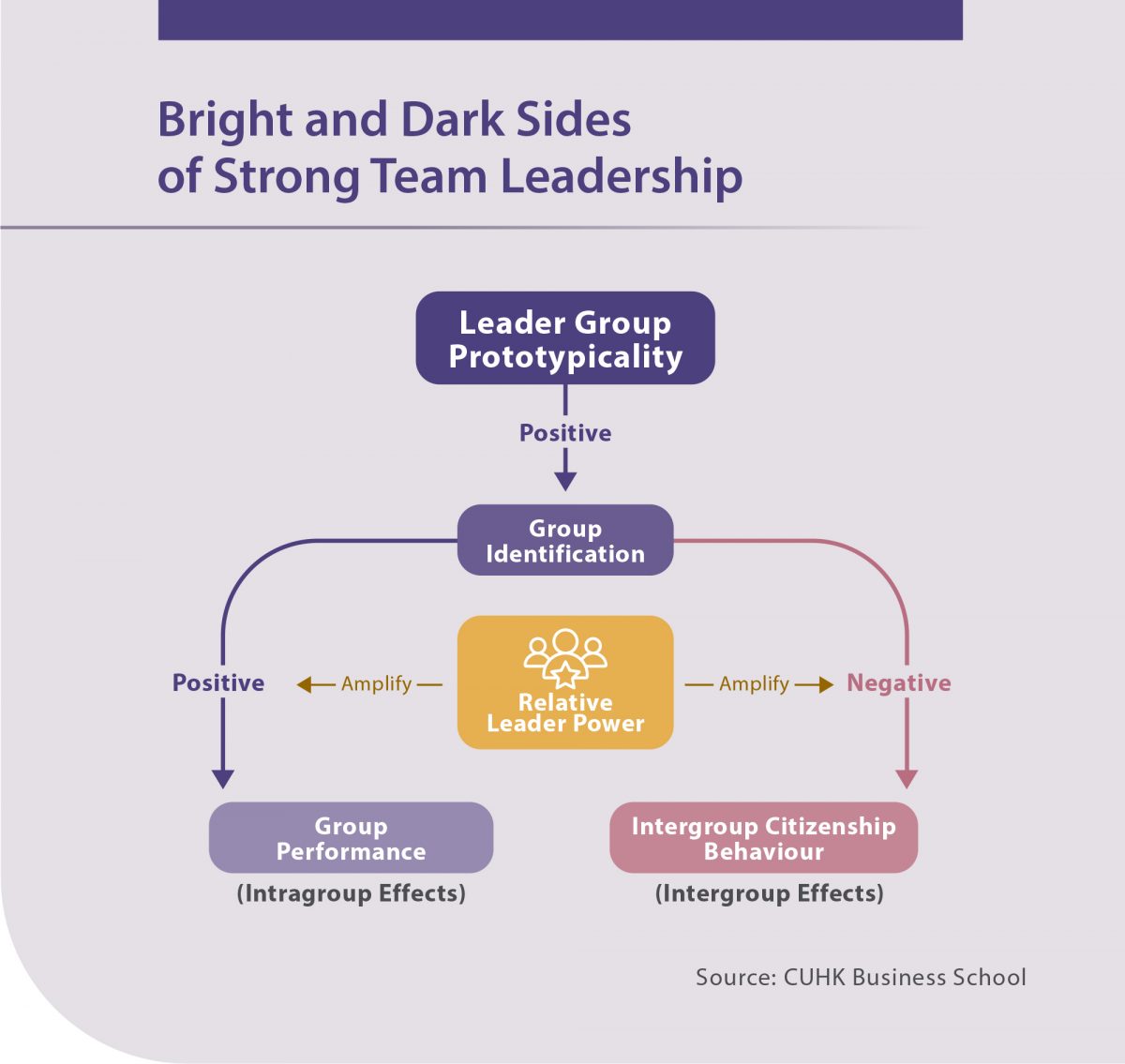The Pros and Cons of Strong Team Leadership
• 6 mins read
New research finds that promoting strong team leadership, without additional measures to boost company-wide collaboration, could be counter-productive
The secrets of great leadership are an abiding preoccupation of the business world. Inspiring leaders can spur us to our greatest achievements and, if your career has prospered under a talented line manager, you will probably be grateful to them for years to come.
However, a new study by Kenneth Law, Professor and Chairman of the Department of Management at the Chinese University of Hong Kong (CUHK) Business School, suggests the prevailing belief that promoting strong team leadership is the key to boosting employees’ performance – and hence increasing company returns – may need to be reconsidered.
Entitled Integrating the Bright and Dark Sides of Leadership: An Investigation of the Intragroup and Intergroup Effects of Leader Group Prototypicality, the study was conducted by Prof. Law, in collaboration with Prof. Yongyi Liang and Prof. Ming Yan of Jinan University, Dr. Haibo Wang of Guangdong University of Foreign Studies and Prof. Yuanyi Chen of Hong Kong Baptist University. They noted that while much prior research has focused on the positive effect of such leaders within teams, little attention has been paid to their potentially negative impact on group interactions across a company.
“If a higher level of leader group prototypicality has negative influences on intergroup relations, leader group prototypicality needs to be carefully managed.”
Prof. Kenneth Law
“To the best of our knowledge, studies on the coexistence of both the pros and cons of leader group prototypicality and their effects on group outcomes are scant,” says Prof. Law. “However, if the negative consequences of leader group prototypicality are inevitable, organisations should be careful when promoting the prototypicality of group leaders.”
Prototypical Leaders Gain More Trust within Team
The study draws on the established paradigm of social identity theory in leadership research. This posits that teams led by line managers who are more prototypical of the group achieve higher performance levels because members are more attracted to the leader and place greater trust in them. As a result, leader group prototypicality has a positive effect within the team.
However, the researchers propose that leader group prototypicality may simultaneously have the negative effect of decreasing team members’ engagement with other teams in the company – known as intergroup citizenship behaviour – through the mediating factors of “group identification” and “relative leader power”.
“We argue that relative leader power enhances the effects of leader group prototypicality on intragroup and intergroup outcomes through members’ social identification that ‘our group is superior to other groups’,” says Prof. Law.

The researchers devised a model to investigate the interactions between leadership group prototypicality; group identification; and relative leader power; and their effects on employees’ behaviour both within teams and between teams.
The model was tested through a two-part survey of employees at five electrical appliance and textile companies in China’s Guangdong Province. A total of 527 team members and 126 team leaders in the firms’ customer service and sales departments were sent two questionnaires one month apart, with a response rate of 70% for team members and 81% for team leaders.
In the first survey, team members were asked for their personal details and perceptions of their boss, while team leaders were asked for personal details plus perceptions of their relative power within the company. In the second survey, team members were asked to evaluate their group, while team leaders were asked to evaluate the team’s overall performance and how well it collaborated with other teams in the company.
Respondents were asked to rate their views on a scale of 1-5 or 1-7 to statements such as “My group leader represents what is characteristic about my work group” for team members; and “Relative to other group leaders within the company, I think I have a lot of control” for team leaders.
Intragroup Effects VS. Intergroup Effects

Statistical analysis confirmed the study’s hypotheses, showing that leader group prototypicality had a positive relationship with the group identification of team members, while the latter was positively associated with intragroup performance and negatively associated with intergroup citizenship behaviour. Meanwhile, relative leader power was shown to amplify both the positive effect of group identification on a team’s performance and the negative effect of group identification on intergroup citizenship behaviour.
The researchers concluded that leader group prototypicality could lead to detrimental intergroup behavioural reactions on the part of team members, as well as favourable intragroup outcomes such as better team performance. “If a higher level of leader group prototypicality has negative influences on intergroup relations, leader group prototypicality needs to be carefully managed,” says Prof. Law.
The study advances empirical knowledge of social identity theory in the context of business leadership through its novel focus on team members’ identification with their team or group, rather than their individual perceptions of the team leader, and on group performance.
However, the researchers stress that the crucial take-away for business leaders is the detrimental influence that relatively powerful prototypical team leaders can have on the collaboration between teams in a company – and hence on the firm’s overall performance.
Adapt Different Approaches to Different Situations

“We draw the attention of practitioners to the trade-off between the positive in-group effects and negative out-group effects of leader group prototypicality,” says Prof. Law. “Team leaders need to compensate for the negative out-group effects in their day-to-day management of the team, by presenting intergroup relations in a positive light and encouraging collaboration.”
The study also points to key lessons at the organisational level for senior management. Positive intergroup relationships are crucial to the success of modern companies, because firms rely on collaboration between departments and teams to develop products and processes.
“Organisations should be scrupulous in the way they empower specific teams in order to minimise the negative effects of leader group prototypicality on cooperation between teams,” says Prof. Law. “One solution is to adopt a flat organisational structure.”
Teams that work within a flat structure have equal responsibility and power to access the human, capital and informational resources within the organisation that are needed for collaboration towards its objectives, he explains.
“By emphasising the functional complementarity of teams within an organisation, a flat and collaborative structure accentuates the way that they excel in diverse areas rather than comparing them by the same criterion,” Prof. Law says.
“However, where one team works exclusively on a particular task, its high status may be emphasised – without detrimental effects – to help the team leader motivate team members to improve their performance further. Our framework can help managers to adapt their approach to a variety of group work situations.”







